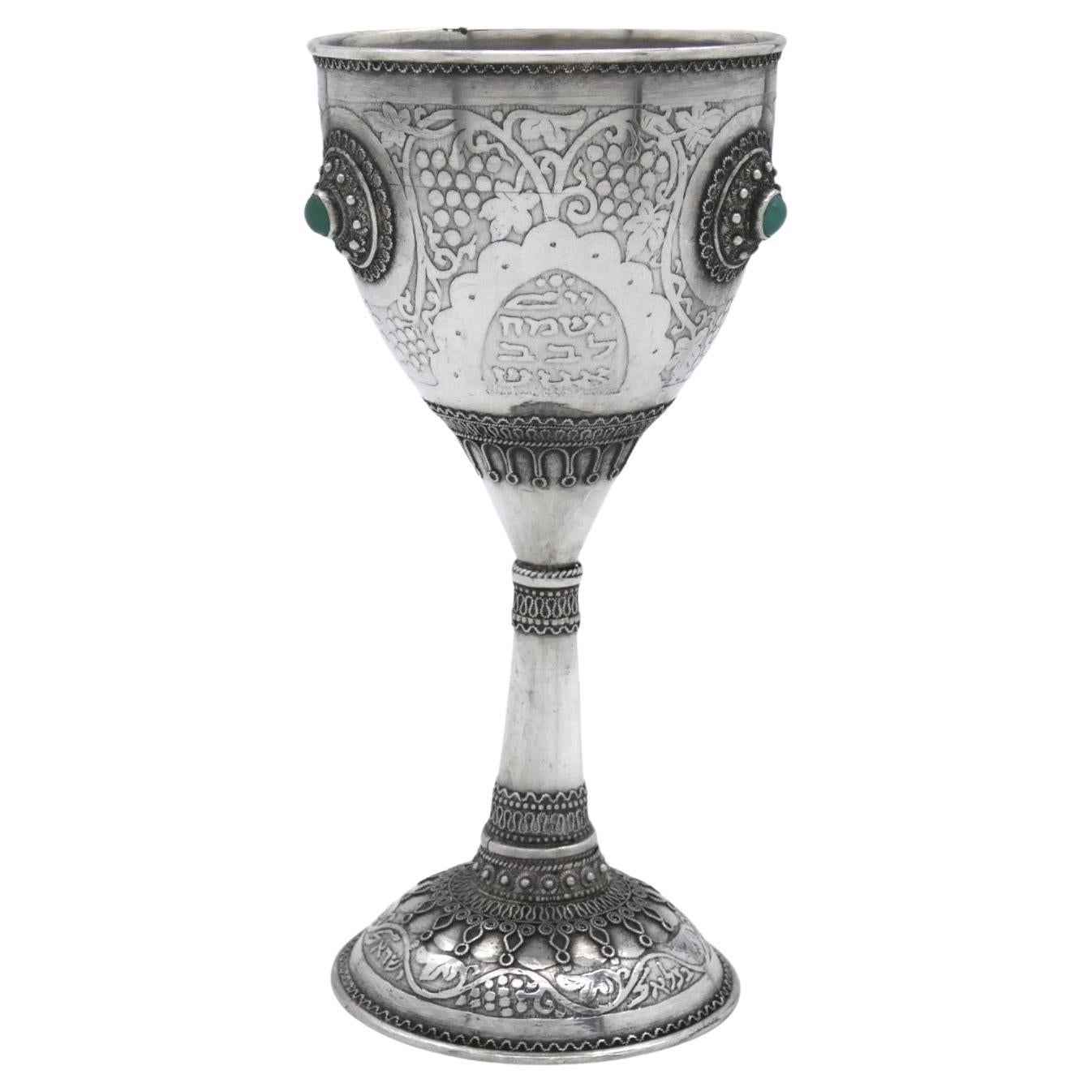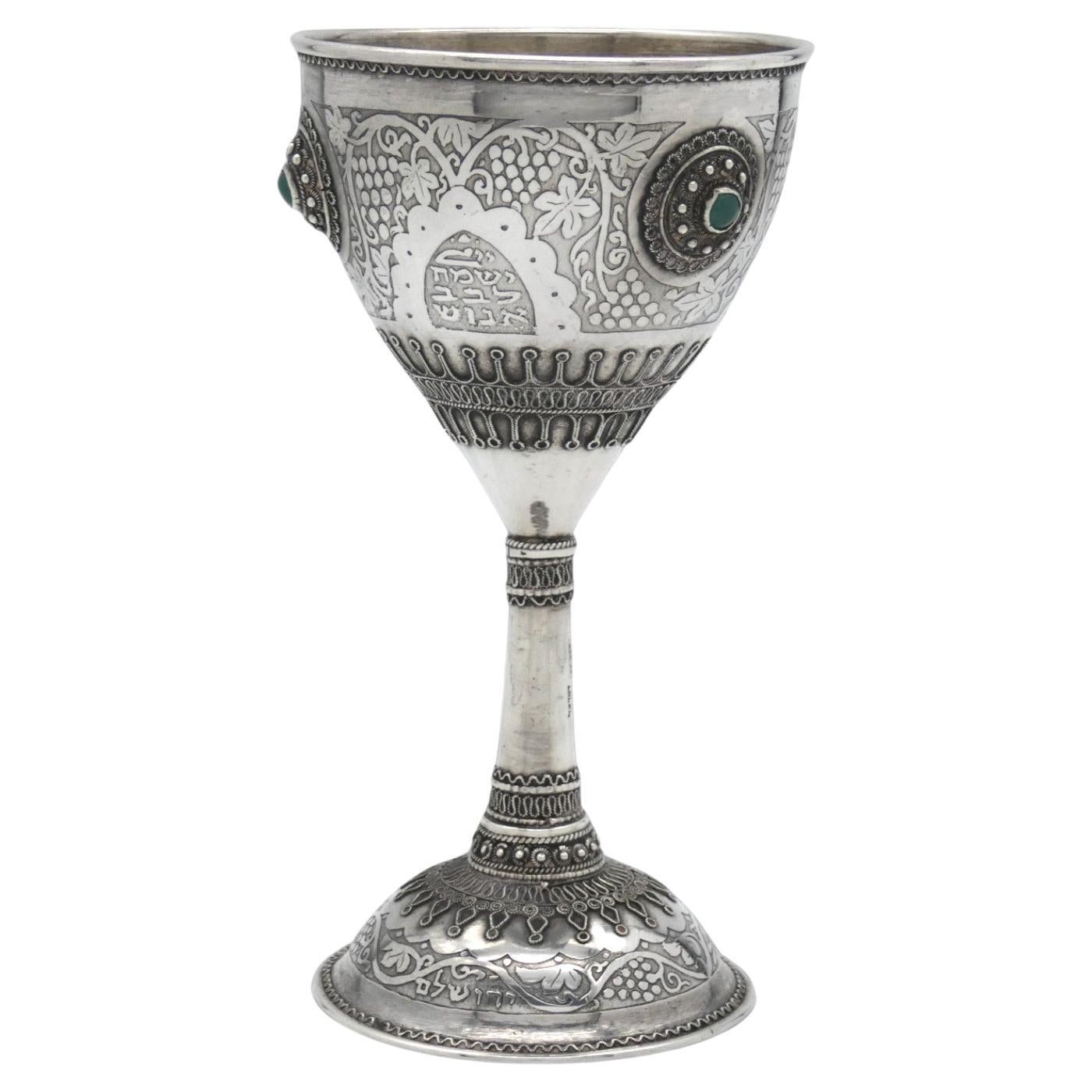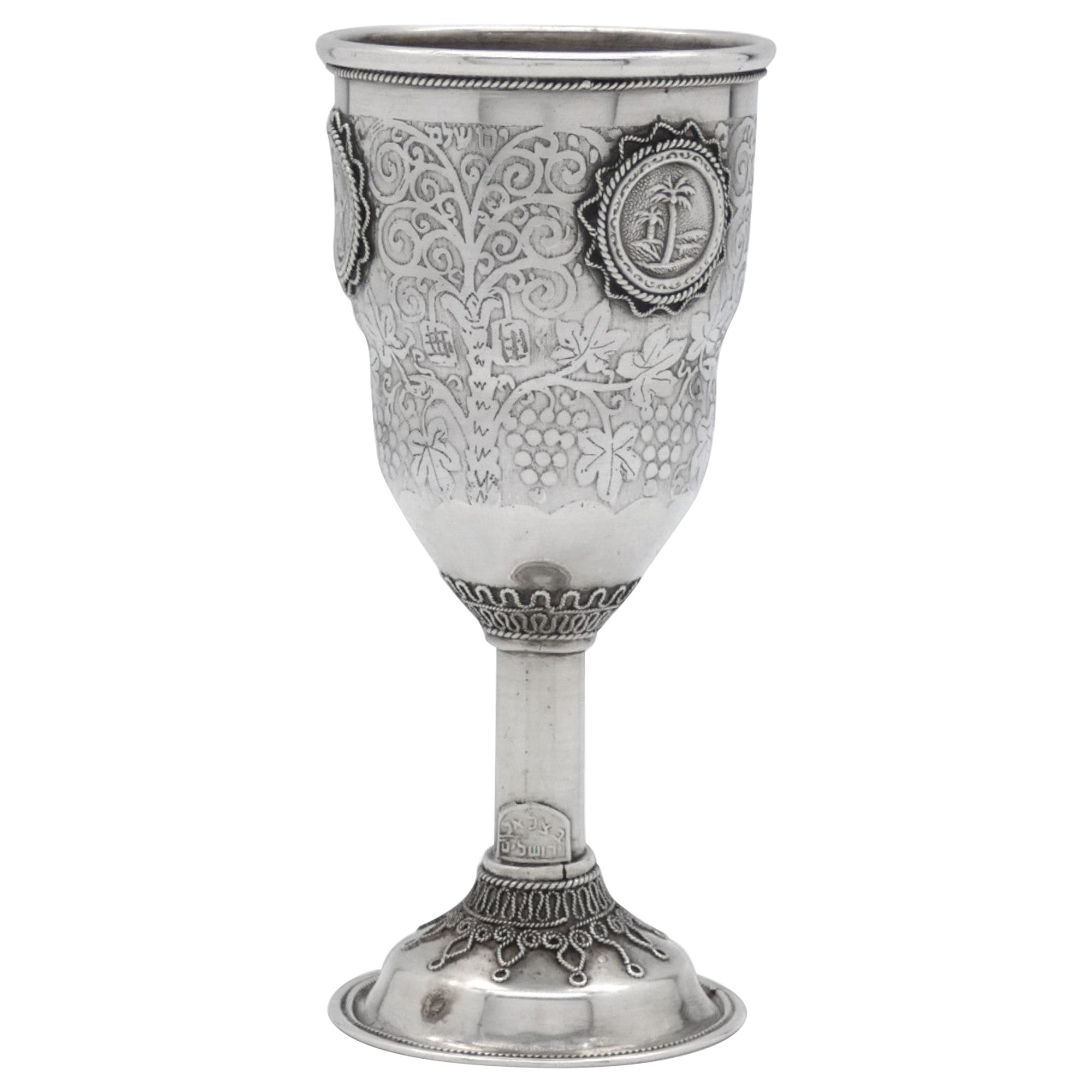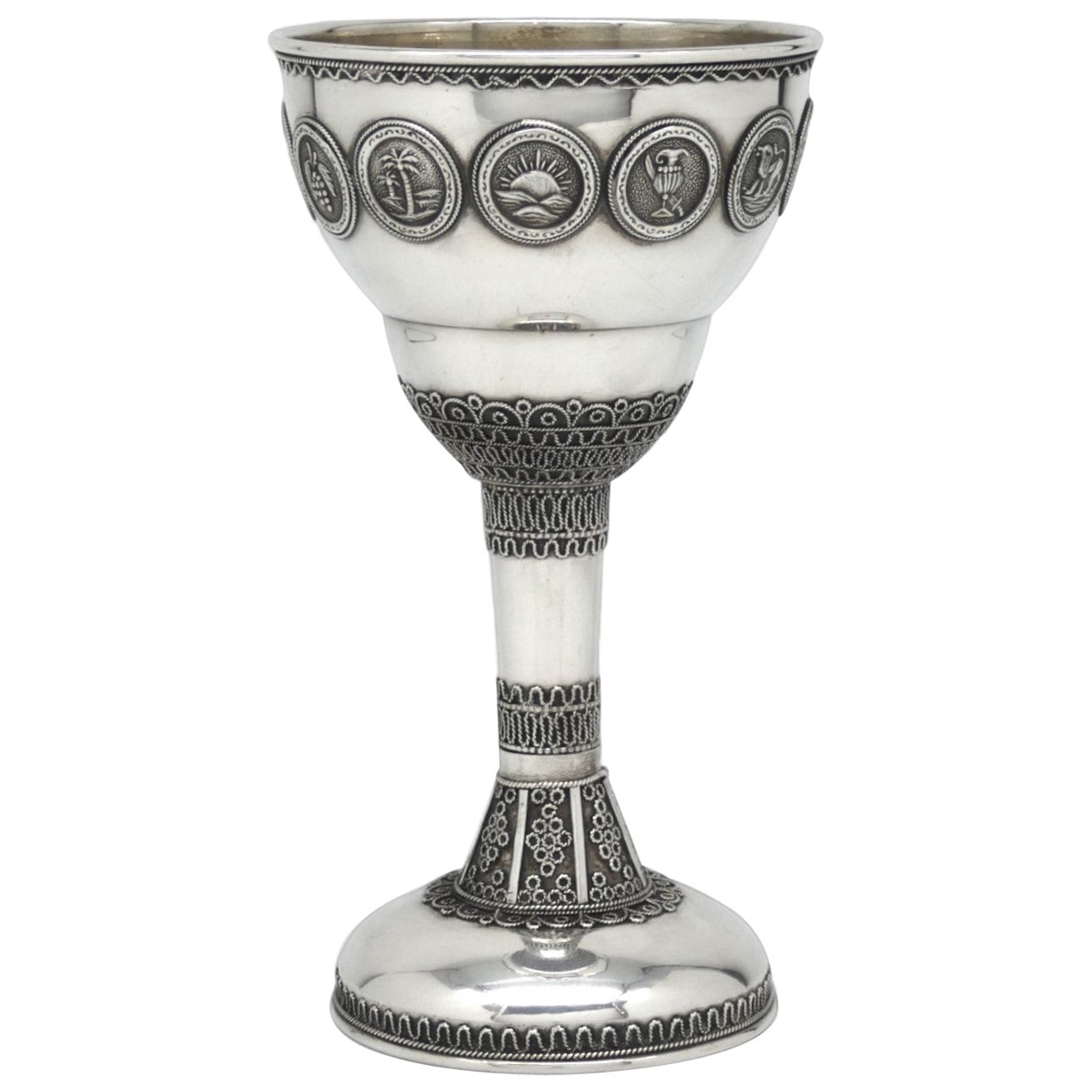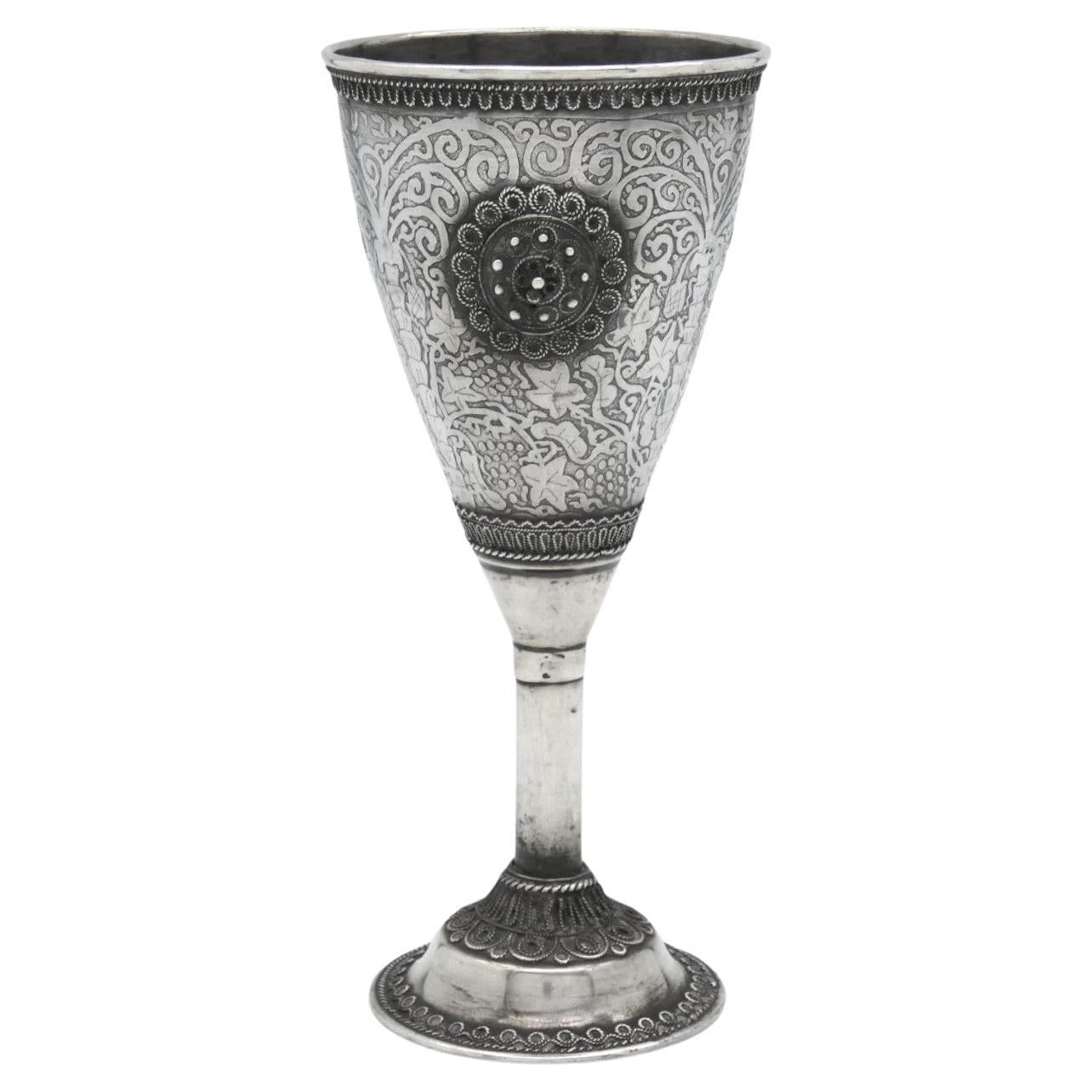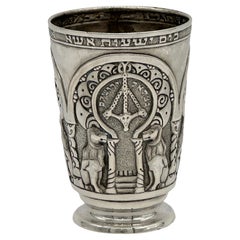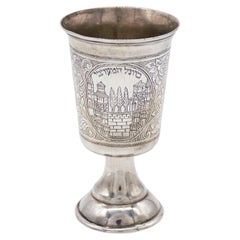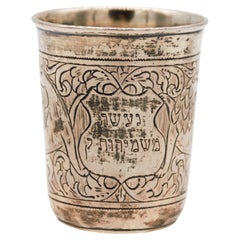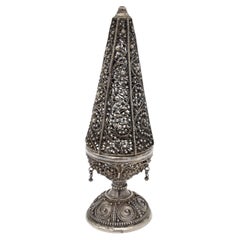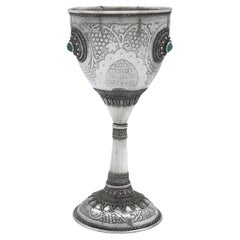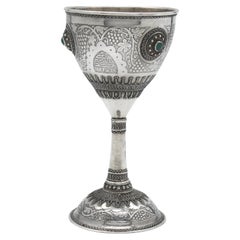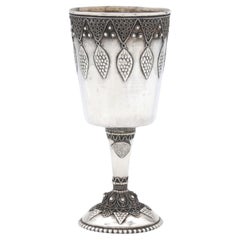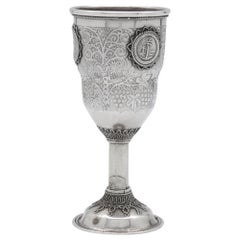Items Similar to Important Early 20th Century Silver Kiddush Goblet by Bezalel School Jerusalem
Video Loading
Want more images or videos?
Request additional images or videos from the seller
1 of 8
Important Early 20th Century Silver Kiddush Goblet by Bezalel School Jerusalem
$8,000
£6,106.88
€7,020.27
CA$11,257.43
A$12,518.73
CHF 6,575.11
MX$153,054.03
NOK 81,932.14
SEK 77,239.88
DKK 52,393.89
About the Item
Important Handmade sterling silver Kiddush goblet by Bezalel School, Jerusalem, circa 1910-1913.
On round base decorated with silver filigree and Cabouchon shaped green agate applications.
The base fitted with Bezalel mark. The upper portion is all adorned with amazing filigree work, the base and the actual cup adorned with swirling filigree designs, in the middle there are 3 roundels, made in another technique of hammered silver, similar to the works that were produced in this time all over Europe, in the middle of each roundel there is a perfectly centered Cabouchon green agate.
This work is attributed to Yehia Yemini.
The goblet is marked on the base, with the earliest silver mark of the school that just say "Bezalel" in Hebrew.
Yehia Yemini :
Was one of the biggest and must famous Bezalel silversmiths ,
Born in 1897 into a family of San'a silversmiths, Yehia Yemini reached Jerusalem with his family at the young age of three. When Bezalel founded its Silver Department In 1908, Yemini became one of its employees, and helped other Yemenites to forge Bezalel's unique synthesis of East and West. After the dismissals of 1914, Yemini joined three groups of Jerusalem craftsmen who specialized in silver crafting in the manner of Bezalel: "Keter," "Kav Lavan," and "Sharar" .
Bezalel School of Arts and Crafts:
Established in 1906 by artist Boris Schatz as the “Bezalel School of Arts and Crafts”,
Bezalel has evolved into one of the world's most prestigious art schools.
The name Bezalel is synonymous with more than 100 years of Israeli art, innovation and academic excellence.
Bezalel’s unique strength stems from the numerous breakthroughs it has been responsible for and its ability to respond and adapt to cultural changes. It takes pride in its numerous generations of graduates, the spearhead of Israeli artists, designers and architects, in Israel and around the globe. The Bezalel Academy of Arts and Design is, first and foremost, a group of talented, inspired and motivated artists and professionals.
Both faculty and students are driven by a passion to create and by their dedication to quality and excellence.
These two pillars of the Academy have placed Bezalel at the epicenter of Israel’s cultural discourse and at the forefront of its artistic scene, making it instrumental in shaping the country’s cultural identity.
The Silver Department at "Bezalel":
Boris Shatz founded an art-and-crafts school in Jerusalem in 1906, naming it "Bezalel" for Bezalel Ben Uri, builder of the First Temple of biblical times. The Bezalel School heralded efforts to forge links with a broad range of Jewish artistic traditions from East and West. The school's daring innovation offered a leading role to the local Yemenite community, particularly in the Filigree Silver Department, which was inaugurated in 1908. By 1913, the Bezalel Silver Department numbered some eighty employees, among them Yehia Yemini, who had been working there from the outset. Department head, Shmuel Persov, taught new concepts of filigree work that were not always familiar to his Yemenite employees; thus, the craftsmen, who ranged from children to the elderly, produced filigree work influenced both by the Yemenite and the East European style. Yehia Yemini distinguished himself with the quality of his work; his designs were interspersed with classical hammerings of Biblical heroes, holy places and tribal emblems and embellished with traditional verses. Filigree work was used with etching and hammering, with settings of stones, and with mother-of-pearl and enamel, as well as granulation and fine flowery adornment in the style of Russia and Poland. With his multi-dimensional perspective and outstanding Yemenite handcrafting skills, he created a pluralistic and eclectic style that came to embody the Bezalel Silver Department
Dimensions:
Height 12cm / 4.6"
Width 5.3cm / 2.2"
Weight 85 grams
- Dimensions:Height: 4.6 in (11.69 cm)Width: 2.2 in (5.59 cm)
- Style:Jugendstil (Of the Period)
- Materials and Techniques:Silver,Hammered
- Place of Origin:
- Period:
- Date of Manufacture:1910-1913
- Condition:Wear consistent with age and use. Very good condition, no brakes, repairs or dents, some light scratches the inner part of the cup lost some of its original gilding.
- Seller Location:Tel Aviv - Jaffa, IL
- Reference Number:1stDibs: LU8130233695672
About the Seller
No Reviews Yet
Vetted Professional Seller
Every seller passes strict standards for authenticity and reliability
1stDibs seller since 2023
- ShippingRetrieving quote...Shipping from: Tel Aviv - Jaffa, Israel
- Return Policy
Authenticity Guarantee
In the unlikely event there’s an issue with an item’s authenticity, contact us within 1 year for a full refund. DetailsMoney-Back Guarantee
If your item is not as described, is damaged in transit, or does not arrive, contact us within 7 days for a full refund. Details24-Hour Cancellation
You have a 24-hour grace period in which to reconsider your purchase, with no questions asked.Vetted Professional Sellers
Our world-class sellers must adhere to strict standards for service and quality, maintaining the integrity of our listings.Price-Match Guarantee
If you find that a seller listed the same item for a lower price elsewhere, we’ll match it.Trusted Global Delivery
Our best-in-class carrier network provides specialized shipping options worldwide, including custom delivery.More From This Seller
View AllImportant Early 20th Century Silver Kiddush cup by Bezalel School Jerusalem
Located in Tel Aviv - Jaffa, IL
Important Handmade sterling silver Kiddush goblet by Bezalel School, Jerusalem, Circa 1910-1913.
On the cup there are 3 identical scenes of flanked lions and on the middle of them There are two columns with a staircase, this design is probably taken from Eastern European torah ark, on the middle part there is a chandelier with 3 tiger/lioness Heads, the top of the cup has 3 inscription on top of each flanking lions scene, first One says : ״כוס ישועות אשא״ (Psalms 116:13) which means " I will take the cup of Salvation", this is a rather common blessing on kiddush cups.
Next inscription says : ״אין שמחה אלא ביין״ in English " there is no joy except in wine" This says that after the temple was destroyed we have our joy only in the wine of Kiddish.
The last inscription says ״ושמחת בחגך״ (Deuteronomy 16:14 ) in English : "And you shall rejoice in your festival".
So this cup is a kiddish cup...
Category
Vintage 1910s Israeli Art Nouveau Sterling Silver
Materials
Silver
Rare "Safed" kiddush cup, late 19th century Poland/ Eretz ISRAEL
Located in Tel Aviv - Jaffa, IL
This 84 silver cup was made in Europe, in Poland or parts of Poland that are in modern Russia in the 19th century, the interesting and important in this cup types is that they were s...
Category
Antique 1890s Israeli Sterling Silver
Materials
Silver
A RARE SILVER SHMIROT KIDDUSH CUP. Galician, c. 1850.
Located in Tel Aviv - Jaffa, IL
A RARE SILVER SHMIROT KIDDUSH CUP. Galician, c. 1850.
Among some Hassidic courts, it was a practice for the Rabbi to give a blessed silver coin to his Hassidim as an amulet. Such protection might be given for all manner of life events, from healing from an illness to success in travel and the amulet was carried on the body of the recipient. This custom was particularly popular among the Ryzhiner Hassidim and these coins were called "Shmirot". To such coins were attributed extraordinary power and value and they were treasured with great care and love.
this cup is marked with polish loth 12 mark which indicate silver content of 75%.
Size :
Height 2.3 inch / 6 cm
Width : 2 inch / 5 cm
After the specific event for which they had originally be given, such a coin or coins were used in the making of other objects, which maintained the special aura of the Rabbi. Such a coin would be melted in other silver with the amuletic valued being spread evenly to all the silver. Then a ritual object would be fashioned by a silversmith and the special nature of the item would be inscribed on it, indicating in one of several ways that this object had been made from "Shmirot". this objects include Kiddish cups, a Havdalah tray, a Shabbat salt holder, a Chanukkah Menorah, a Torah crown etc.
This object is a Kiddish cup fashioned from such silver. On this cup, the inscription indicating Shmirot is found in the abbreviation of the words "made from shmirot k (kodesh)' " (This is the cup of Shmirot). Such cups were used for blessing the wine so that each use renewed the power of protection granted by the Rabbi. This cup was used for the blessing over wine on Shabbat and holidays. Inscription:
the other iconography on the cup is of a lion that represent Through the tribe of Judah, the lion symbol came to represent the blessing, majesty, and even divine protection of the Jews. The lion symbol continued to be used even after the destruction of Jerusalem, the capital of Judah's nation,
and a unicorn or a re'em, also reëm (Hebrew: רְאֵם), is an animal mentioned nine times in the Hebrew Bible It has been translated as "unicorn" in the Latin Vulgate, King James Version, and in some Christian Bible translations as "oryx" (which was accepted as the referent in Modern Hebrew),[citation needed] "wild ox", "wild bull", "buffalo" or "rhinoceros". Rabbi Natan Slifkin has argued that the re'em was an aurochs, as has Isaac Asimov...
Category
Antique 1850s Sterling Silver
Materials
Silver
Early 20th Century Silver Spice Tower by Yehia Yemini, Bezalel School Jerusalem
Located in Tel Aviv - Jaffa, IL
Very rare Bezalel Jerusalem silver filigree spice tower, this amazing spice Tower was Made by Yehia Yemini, who was the best filigree artist in bezal...
Category
Vintage 1920s Israeli Sterling Silver
Materials
Silver
Russian Art Nouveau silver punch set, with The Three Bogatyrs, best quality
Located in Tel Aviv - Jaffa, IL
Comprising a punch bowl, ladle and six cups each cast with armed bogatyr with Weapons and inscription through coniferous mountain landscapes the punch bucket is sitting on owl shaped...
Category
Vintage 1920s Russian Art Nouveau Sterling Silver
Materials
Silver
JUDAICA SILVER ETROG BOX DESIGNED BY LUDWIG WOLPERT. New York, 20th century
Located in Tel Aviv - Jaffa, IL
This charming piece of jewish history in front of you is a one of kind modern Judaica object,
This box used to hold the Etrog To protect the it during the holiday of Sukkot, it is traditionally Wrapped in silky flax fibers and stored in a special decorative box, mostly made from silver.
Wolpert designed this amazing hand hammered Bauhaus style box in 1963-1964 while he was Working in New York. all of the boxes we could found from this design made by Wolpert have The upper part inscribed in a simple engraving with the phrase "Pri Etz Hadar"
In Hebrew ״פרי עץ הדר״. the box in front of you is the only example in existence as far as we Know where the letters are also repoussé and also engraved, such a beautiful and hard to get Combination, the rest of the box is shaped as a modernistic Etrog, all the body of the box is Skillfully hand hammered in a way it reflects the light in a warm and calm way, a true Masterpiece of modern judaica by the great and important artist Ludwig Yehuda Wolpert.
One of the the two great masters of 20th century Judaica.
the Box is marked "WOLPERT" AND "STERLING" and the base has the engraved inscription :
"ALAN WECHSLER GENERAL CHAIRMAN, ALLIED JEWISH APPEAL OF SOUTHERN NEW JERSEY 1978"
Similar boxes can be find in museum collections around the world
In the Jewish Museum New York
In the North Carolina Museum of Art
In The Derfner Judaica Museum
Another similar box was featured in the Israel Museum exhibition
"Forging Ahead, Wolpert and Gumbel, Israeli Silversmiths for the Modern Age"
Ludwig Yehuda Wolpert was born in Hildesheim, Germany, to an Orthodox family. In 1916-1920, He began his studies in sculpture at the Frankfurt School of Art. In 1925-1928, he studied Goldsmithing at the Frankfurt School of Art.
Following the presentation of the works in the 1930 exhibition "Kult und Form" ("Ritual and Form") at the Jewish Museum in Berlin, his works became well known in the German Jewish World. His works were greatly influenced by Modernist design, especially the Bauhaus Movement. Wolpert's works avoid decoration, relying on clean, geometric shapes. In 1933, Following the Nazi rise to power in Germany, he immigrated to the Mandatory Palestine with His family. There he worked for two years in the workshop of Bernhard Friedländer, where he Designed and produced silverware and Jewish ceremonial art.Together with Victor Solomon...
Category
Vintage 1960s Decorative Boxes
Materials
Silver
You May Also Like
A Silver Bezalel Kiddush Goblet, Israel Circa 1950, Judaica, Jerusalem
Located in New York, NY
This silver acid-etched Bezalel Kiddush goblet from Israel circa 1950 is a beautiful piece of Judaica with significant artistic and cultural value.
The Bezalel Academy of Arts and ...
Category
Vintage 1950s Israeli Sterling Silver
Materials
Silver
$2,000 Sale Price
20% Off
A Silver Bezalel Kiddush Goblet, Israel Circa 1950
Located in New York, NY
An Impressive Applied Filigree Silver Kiddush Goblet made by Bezalel in Israel, Circa 1950.
Another magnificent piece of Bezalel craftsmanship at its finest. Bezalel's style and par...
Category
Mid-20th Century Israeli Sterling Silver
Materials
Silver
$2,640 Sale Price
20% Off
A Silver Kiddush Goblet by Bezalel, circa 1950
Located in New York, NY
An Unusual Silver Kiddush Goblet by Bezalel, made in Israel circa 1950.
Expertly made Kiddush Goblet embellished with beautiful Filigree is a classic design made by Bezalel.
Circul...
Category
Mid-20th Century Israeli Mid-Century Modern Sterling Silver
Materials
Silver
$3,040 Sale Price
53% Off
A Silver Kiddush Goblet by Bezalel, Circa 1950
Located in New York, NY
A Traditional Silver Kiddush Goblet by Bezalel, made in Jerusalem Circa 1950.
Kiddush Goblet has excellent filigree scrolling along its domed base and the lower main body.
A small plaque with the words "Bezalel Jerusalem" are written in Hebrew at the base of the stem.
Foliate, vines, and grape cluster engravings enhance the body of the goblet serving as the background for the three filigree encircled medallions embellished on its sides.
Medallions feature motifs of date palm trees...
Category
Mid-20th Century Israeli Mid-Century Modern Sterling Silver
Materials
Silver
$2,800 Sale Price
20% Off
A Silver Kiddush Goblet by Avishai
Located in New York, NY
A Filigree Designed Silver Kiddush Goblet by Avishai made in Israel in the mid-20th century.
Goblet rests on a circular domed base bordered by scrolling filigree patterns.
The uppe...
Category
Mid-20th Century Israeli Sterling Silver
Materials
Silver
$2,400 Sale Price
20% Off
A Silver Kiddush Goblet by Avishai, Israel Circa 1950
Located in New York, NY
A silver acid-etched Kiddush goblet by Avishai, made in Israel around 1950, is a significant piece of Judaica with both artistic and cultural value.
Avishai is a known Israeli silversmith whose works are characterized by meticulous craftsmanship and innovative design. This Kiddush Goblet is made in a Bezalel School style and designed by Avishai with acid-etched designs and typical Bezalel iconography. The 1950s were formative years for the newly established State of Israel, with a burgeoning arts and crafts movement that sought to blend traditional Jewish themes...
Category
Vintage 1950s Israeli Sterling Silver
Materials
Silver
$1,520 Sale Price
20% Off
More Ways To Browse
Antique Hammer Heads
Russian Silver Cup
Russian Goblet
Antique Glass World Globe
Antique Russian Silver Cup
Sterling Kiddush Cups
Sterling Silver Kiddush Cup
Temple Pillars
Kiddush Goblet
Antique Kiddush Cup
Antique Kiddush Cups
Antique Silver Kiddush Cup
Russian Enamel Cup
Boris Schatz
Jerusalem Mother Of Pearl
Russian Kiddush Cup
Antique Russian Silver Kiddush Cup
Agate Cup
